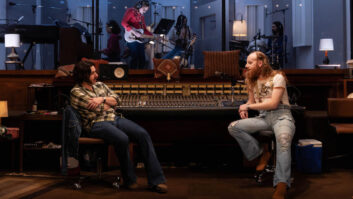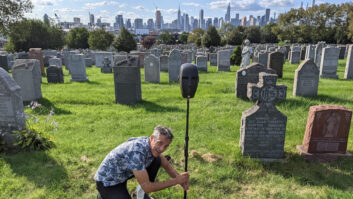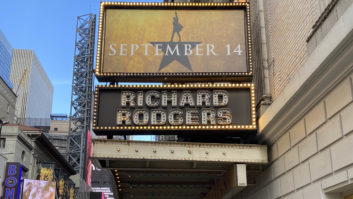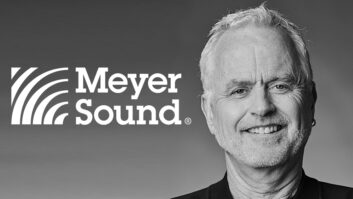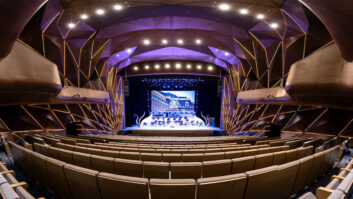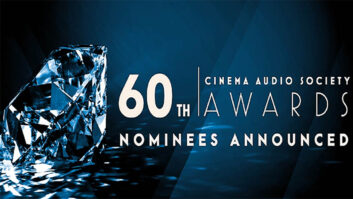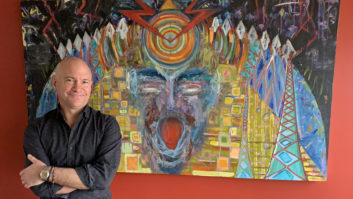NEW YORK CITY, NY—People the world over may know Idina Menzel as the voice behind the omnipresent “Let It Go” in the recent animated film Frozen, but the singer has been wowing crowds in person this spring, playing the lead role in If/Then on Broadway. An intricate new musical, the show follows Elizabeth (Menzel), a recent divorcee who moves to New York City. When she faces a seemingly innocuous choice, the storyline splits in half and follows the heroine as her life goes in two very different directions.
Idina Menzel and James Snyder are two of the principal castmembers in If/Then who are double-miked with DPA 4061s. Ensuring that the audience can follow the play and tell which version of Elizabeth and her coterie they’re watching was a challenge to the creative team, which includes director Michael Greif, working from a book and lyrics by Brian Yorkey and theatrical score by Tom Kitt. Given that it’s a musical, sound inevitably plays a strong role in helping the audience follow along, so Tony Award-winning sound designer Brian Ronan and theatrical sound reinforcement, installation and design company, Masque Sound, had their work cut out for them.

While it opened at the Richard Rodgers Theater on the Great White Way in April, the show’s initial run was at the National Theater in Washington, DC in November last year. That run required three weeks of David Dignazio (sound engineer), Jim Wilkinson (assistant sound engineer) and Mike Tracey (associate sound designer for Washington; A2 sub for Broadway) building the system in Masque Sound’s shop, followed by three weeks of teching and previews in Washington. The result was a system that required minimal reworking when the show went to New York.
Aphex 1788 mic preamps are used for the split, sending audio to Dignazio’s DiGiCo SD7T house console at the back of the upper orchestra seats, and an Avid Venue Profile monitor desk beneath the stage. Monitor mixes are sent to numerous Aviom 16-channel personal mixers used by the orchestra, and to other places. “We have 32 channels of wireless and five IEMs to do special effects speakers,” said Tracey. “For instance, there’s a baby in a scene, so there’s an IEM with a small Altec speaker in a doll. We also have an actor who plays acoustic guitar on stage; he was really struggling to hear and we didn’t want to blast his guitar at everybody, so we gave him an IEM so he can monitor the band and himself more clearly.” Additionally, small Meyer Sound MM4 speakers can be found in numerous plexiglass tunnels that castmembers pass through during the show, helping ensure actors hear their cues.
The four principals are double- miked, all run through Grace m802 preamps. The cast is wearing Sennheiser SK 5212-II bodypack transmitters attached to a mix of “… Sennheiser MKE2s and MKE1s and DPA 4061s, but we went mainly with the DPAs because they make a good beige,” said Tracey.
DPA 4061s can also be found in the orchestra pit, clipped to the strings while Neumann KM 185s act as overheads; working in tandem with an Avalon DI on the cello; and Y-ed together on the accordion in order to achieve enough gain during louder numbers. Guitars and electric bass are run through Avalon DIs and Fractal Audio guitar processors instead of amplifiers, while the acoustic bass is captured with a combination of an Opus Audio DI 1000 and a Neumann U87.
L-Acoustics V-Dosc arrays are used to cover the orchestra, mezzanine and balcony, with d&b audio-technik E3s used for stage front-fills, getting additional orchestra support from two flown Meyer Sound UPA-2Ps aimed down at the first four rows, and single CQ-1 and UP Junior boxes used to cover seats on the outskirts. Left and right opera boxes on the sides of the proscenium hold arrays of five dV-Dosc speakers groundstacked on subs to cover the Mezzanine and Balcony. Other speakers in the system include d&b audiotechnik E8s and B2 subs; L-Acoustics dV-Subs; and Meyer CQs used for balcony delays and UPA-1Ps used as effects speakers, hung from trusses but facing upwards. “They bounce off the dome and the ceiling, helping to spread some of the sound effects and widen them,” said Dignzaio. “We don’t have a surround system, but we have things that pan one direction or the other through the main system.”
And handling those effects? Tracey explained, “We’re using a QLab 3 system and then we’re using the DiGiCo UB MADI to run it into the SD7 console. It’s just a little box that goes USB-in, MADI-out; we could do up to 48 channels of sound effects into the console, but we’re using only 12.”
Another engineering feat is present back down beneath the stage in the form of a video distribution package handling closed-circuit HD video used by the stage crew, performers, conductor and stage manager. “We’re using ETS SDS887 video distribution hubs to do all the distribution of safety shots—the video signals hit a 4-channel Balun [transceiver], put them into Cat 5 twisted pairs, and that’s the whole system basically,” said Tracey. “The rack next to it is our com—it’s Clear-Com and Telex for the wireless. We have eight channels of com.”
While If/Then didn’t fare well at the Tonys, Menzel nonetheless got to belt the show’s signature tune, “Always Starting Over” during the awards show and the musical continues to draw big crowds.
Masque Sound
masquesound.com
DPA Microphones
dpamicrophones.com
